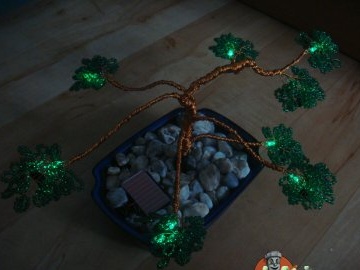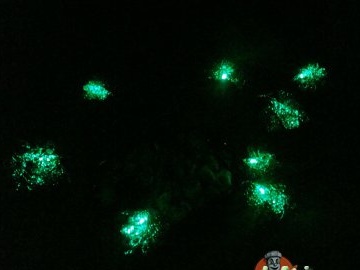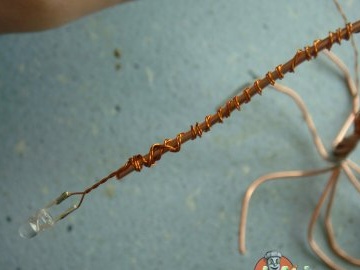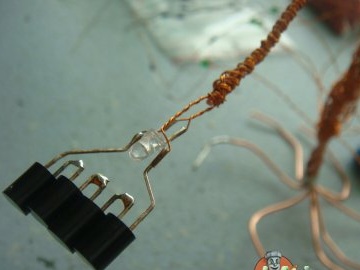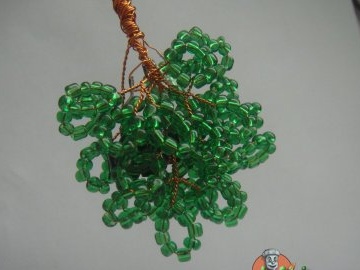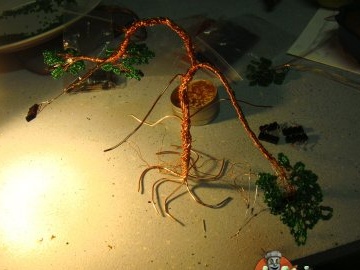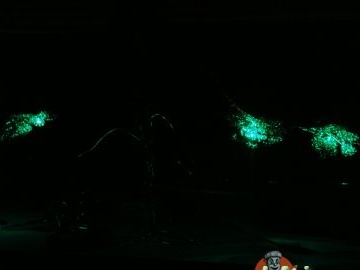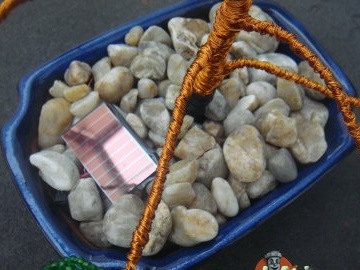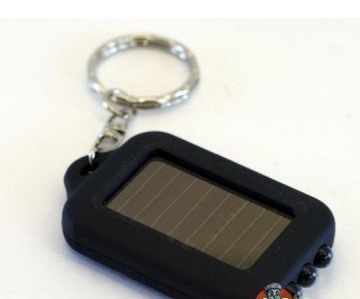Surely you have seen bead trees, man-made creation of an analogue of natural beauty, less affected by time. The advantage of such trees in a more “rapid growth" and the ability to set a unique shape, accurately recreating the mental image.
Not so long ago, “eternal flashlights” appeared on the market, in particular, devices with LEDs and solar panels.
We combine the above, and coupled with zeal, we can get a luminous bonsai from beads, which looks like this:
in the afternoon
In the dark,
at night.
Manufacturing technology
Energy collection for recharging can be carried out in one of two directions:
1) Placement of photodiodes in the branches of a tree;
2) Installing one solar cell next to a tree.
Creating a tree.
It all depends on your imagination, skill and diligence. For the given example, it was necessary to purchase about 60 meters of copper wire with a diameter of 0.3 mm and 2160 beads with a diameter of 3 mm. There can be any beads, but in his desire to recreate the effect of the leaves, he used transparent green, 80 grams.
The very first stage, we make twigs with leaves.
Next, you need to create a solid wire frame with a diameter of about 2 mm, it will be a tree trunk. When placing LEDs on the branches, leave a margin of length, as shown in the photo. So it will be more convenient for further assembly. A root margin is also required to assemble the circuit.
Installation of the LED on the branch frame:
If you want to use the placement of photodiodes on the branches, then the design will look like this:
I used branches with photo and LEDs and five leaf branches. To create a natural effect, we place dark photodiodes in the center, and the LED at the beginning of the points with leaves, this will allow them to illuminate the entire branch.
One finished branch:
Half finished wood:
Same thing in the dark:
Now you need to hide electronic filling, there are many options: solder the roots, pass through the holes, pin, etc. In this case, holes were made in the bottom of the pot, roots were passed through them, and after placing the electronics, the container was filled with decorative stones.
Pot with pebbles:
The electronic side of the issue
BPW34 photodiodes were used, if you decided to use this direction of energy supply, then you need to use about 10 pieces together to ensure charging the lithium-ion battery. We place them in the branches and post to the roots.
Due to the location “in the foliage”, photodiodes cannot work at full power due to the light flux reduced by the leaves.
Consider a different solution to the energy supply problem. Keychains with solar panels have long been sold in stores, their price is not high.
Solar LED Flashlight Keychain:
At the first stages of the calculation, the use of a capacitor as the main battery was assumed. But when I used the solar cell from the keychain, I felt sorry for leaving the rest of the keychain out of work, including a 3.7V and 40mAh lithium-ion battery. Using these parts simplified the recreation of the circuit.
Scheme:
If you use BPW34 photodiodes, then you need to use blocks of 10 series-connected photodiodes assembled in parallel.
The solar battery is connected through a diode D1 and a resistor R9, which allows the transistor Q1 to play the role of a dimmer control LEDs based on information about the illumination coming from the solar cell. Thus, the backlight turns on only in the dark and does not take power during the day, making it possible to recharge the battery. It remains only to assemble the LEDs and resistors connected in series to them.
When hiding the electronics with stones, leave the solar cell unclosed, otherwise it will not work.
The list of materials required to create:
2160 beads (about 80 g)
60 m of copper wire with a diameter of 0.3 mm
1 bonsai pot
8 super bright 3mm green LEDs 8000mcd
1 solar panel (or 10 BPW34)
1 lithium-ion battery at 3.7V 40mAh
2 m of copper wire with a diameter of about 2 mm
8 resistors 1 kOhm
1 resistor 1MOhm
1 diode 1N4148
1 transistor BC327
P.S .:
Such luminous trees will be a great decoration for your windows and interior, bringing a little magic to your life.


